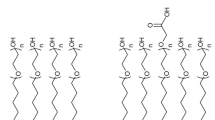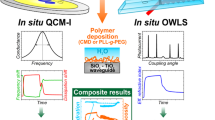Abstract
Biofunctional coatings are key elements of biosensors regulating interactions between the sensing surface and analytes as well as matrix components of the sample. These coatings can improve sensing capabilities both by amplifying the target signal and attenuating interfering signals originating from surface fouling (non-specific binding). Considering the tested materials so far, hydrogel-based layers have been verified to be among the most effective layers in improving biochip performance. The polysaccharide dextran can be efficiently used to form hydrogel layers displaying extended three-dimensional structure on biosensor surfaces. Owing to their high water content and flexible structure, dextran coatings present advanced antifouling abilities, which can be exploited in classic bioanalytical measurements as well as in the development of cell-on-a-chip type biosensors. However, in spite of the numerous applications, the deep characterization of dextran layers has been missing from the literature. This phenomenon can be attributed to the challenging analysis of few nanometer-thick layers with high water content. The lack of available data is more pronounced regarding the layer behaviors under aqueous conditions. In this chapter we present various surface analytical methods (including biosensor-type techniques) suitable for the complex characterization of hydrogel coatings whose thickness ranges from few to several ten nanometers. As a case study, we focus on the analysis of carboxymethyl dextran (CMD) layers developed for waveguide-based label-free optical biosensor applications. Examination methodologies both under dry and aqueous conditions as well as testing of antifouling abilities are also presented.
Access this chapter
Tax calculation will be finalised at checkout
Purchases are for personal use only
Similar content being viewed by others
Notes
- 1.
This principle is analogous to the measurement principle of evanescent field applying sensors, where a standing electromagnetic field over the waveguide layer is generated allowing to sense analytes.
References
Akkoyun A, Bilitewski U (2002) Optimisation of glass surfaces for optical immunosensors. Biosens Bioelectron 17:655–664. https://doi.org/10.1016/S0956-5663(02)00029-5
Balakrishnan B, Banerjee R (2011) Biopolymer-based hydrogels for cartilage tissue engineering. Chem Rev 111:4453–4474. https://doi.org/10.1021/cr100123h
Chandra P (ed) (2016) Nanobiosensors for personalized and onsite biomedical diagnosis. Institution of Engineering and Technology, London
Chandra P, Tan YN, Singh SP (2017) Next generation point-of-care biomedical sensors technologies for cancer diagnosis. Springer, Singapore
Cutiongco MFA, Tan MH, Ng MYK et al (2014) Composite pullulan–dextran polysaccharide scaffold with interfacial polyelectrolyte complexation fibers: A platform with enhanced cell interaction and spatial distribution. Acta Biomater 10:4410–4418. https://doi.org/10.1016/j.actbio.2014.06.029
De Feijter J, Benjamins J, Veer F (1978) Ellipsometry as a tool to study the adsorption behavior of syntetic and biopolyers at the air water interface. Biopolymers 17:1759–1772. https://doi.org/10.1002/bip.1978.360170711
Dutta AK, Belfort G (2007) Adsorbed gels versus brushes: viscoelastic differences. Langmuir 23:3088–3094. https://doi.org/10.1021/la0624743
Elam JH, Nygren H, Stenberg M (1984) Covalent coupling of polysaccharides to silicon and silicon rubber surfaces. J Biomed Mater Res 18:953–959. https://doi.org/10.1002/jbm.820180809
Elender G, Kühner M, Sackmann E (1996) Functionalisation of Si/SiO2 and glass surfaces with ultrathin dextran films and deposition of lipid bilayers. Biosens Bioelectron 11:565–577. https://doi.org/10.1016/0956-5663(96)83292-1
Escorihuela J, González-Martínez MÁ, López-Paz JL et al (2015) Dual-polarization interferometry: a novel technique to light up the nanomolecular world. Chem Rev 115:265–294. https://doi.org/10.1021/cr5002063
Ferreira L, Rafael A, Lamghari M et al (2004) Biocompatibility of chemoenzymatically derived dextran-acrylate hydrogels. J Biomed Mater Res 68A:584–596. https://doi.org/10.1002/jbm.a.20102
Ferreira GNM, Da-Silva A-C, Tomé B (2009) Acoustic wave biosensors: physical models and biological applications of quartz crystal microbalance. Trends Biotechnol 27:689–697. https://doi.org/10.1016/j.tibtech.2009.09.003
Höök F, Kasemo B, Nylander T et al (2001) Variations in coupled water, viscoelastic properties, and film thickness of a Mefp-1 protein film during adsorption and cross-linking: a quartz crystal microbalance with dissipation monitoring, ellipsometry, and surface plasmon resonance study. Anal Chem 73:5796–5804. https://doi.org/10.1021/ac0106501
Höök F, Vörös J, Rodahl M et al (2002) A comparative study of protein adsorption on titanium oxide surfaces using in situ ellipsometry, optical waveguide lightmode spectroscopy, and quartz crystal microbalance/dissipation. Colloids Surf B Biointerfaces 24:155–170. https://doi.org/10.1016/S0927-7765(01)00236-3
Horvath R, Ramsden JJ (2007) Quasi-isotropic analysis of anisotropic thin films on optical waveguides. Langmuir 23:9330–9334. https://doi.org/10.1021/la701405n
Horvath R, McColl J, Yakubov GE, Ramsden JJ (2008) Structural hysteresis and hierarchy in adsorbed glycoproteins. J Chem Phys 129:071102. https://doi.org/10.1063/1.2968127
Horvath R, Gardner HC, Ramsden JJ (2015) Apparent self-accelerating alternating assembly of semiconductor nanoparticles and polymers. Appl Phys Lett 107:041604. https://doi.org/10.1063/1.4927403
Ismail IM, Gray ND, Owen JR (1996) A QCM analysis of water absorption in lithium polymer electrolytes. J Chem Soc Faraday Trans 92:4115. https://doi.org/10.1039/ft9969204115
Johannsmann D (2015) The quartz crystal microbalance in soft matter research. Springer, Cham
Kittle JD, Du X, Jiang F et al (2011) Equilibrium water contents of cellulose films determined via solvent exchange and quartz crystal microbalance with dissipation monitoring. Biomacromolecules 12:2881–2887. https://doi.org/10.1021/bm200352q
Knoll W (ed) (2013) Handbook of biofunctional surfaces, 1st edn. Pan Stanford Publishing, Boca Raton
Kovacs N, Patko D, Orgovan N et al (2013) Optical anisotropy of flagellin layers: in situ and label-free measurement of adsorbed protein orientation using OWLS. Anal Chem 85:5382–5389. https://doi.org/10.1021/ac3034322
Kuhner M, Sackmann E (1996) Ultrathin hydrated dextran films grafted on glass: preparation and characterization of structural, viscous, and elastic properties by quantitative microinterferometry. Langmuir 12:4866–4876. https://doi.org/10.1021/la960282+
Laos K, Parker R, Moffat J et al (2006) The adsorption of globular proteins, bovine serum albumin and β-lactoglobulin, on poly-l-lysine–furcellaran multilayers. Carbohydr Polym 65:235–242. https://doi.org/10.1016/j.carbpol.2006.01.010
Lee MH, Boettiger D, Composto RJ (2008) Biomimetic carbohydrate substrates of tunable properties using immobilized dextran hydrogels. Biomacromolecules 9:2315–2321. https://doi.org/10.1021/bm8002094
Lee T-H, Hirst DJ, Aguilar M-I (2015) New insights into the molecular mechanisms of biomembrane structural changes and interactions by optical biosensor technology. Biochim Biophys Acta Biomembr 1848:1868–1885. https://doi.org/10.1016/j.bbamem.2015.05.012
Lian M, Chen X, Lu Y, Yang W (2016) Self-assembled peptide hydrogel as a smart biointerface for enzyme-based electrochemical biosensing and cell monitoring. ACS Appl Mater Interfaces 8:25036–25042. https://doi.org/10.1021/acsami.6b05409
Linder V, Gates BD, Ryan D et al (2005) Water-soluble sacrificial layers for surface micromachining. Small 1:730–736. https://doi.org/10.1002/smll.200400159
Liu Z, Choi H, Gatenholm P, Esker AR (2011) Quartz crystal microbalance with dissipation monitoring and surface plasmon resonance studies of carboxymethyl cellulose adsorption onto regenerated cellulose surfaces. Langmuir 27:8718–8728. https://doi.org/10.1021/la200628a
Liu J, Qi C, Tao K et al (2016) Sericin/dextran injectable hydrogel as an optically trackable drug delivery system for malignant melanoma treatment. ACS Appl Mater Interfaces 8:6411–6422. https://doi.org/10.1021/acsami.6b00959
Liu M, Zeng X, Ma C et al (2017) Injectable hydrogels for cartilage and bone tissue engineering. Bone Res 5:17014. https://doi.org/10.1038/boneres.2017.14
Löfås S, Johnsson B (1990) A novel hydrogel matrix on gold surfaces in surface plasmon resonance sensors for fast and efficient covalent immobilization of ligands. J Chem Soc Chem Commun:1526–1528. https://doi.org/10.1039/C39900001526
Löfås S, Johnsson B, Tegendal K, Rönnberg I (1993) Dextran modified gold surfaces for surface plasmon resonance sensors: immunoreactivity of immobilized antibodies and antibody-surface interaction studies. Colloids Surf B Biointerfaces 1:83–89. https://doi.org/10.1016/0927-7765(93)80038-Z
Löfås S, Johnsson B, Edström Å et al (1995) Methods for site controlled coupling to carboxymethyldextran surfaces in surface plasmon resonance sensors. Biosens Bioelectron 10:813–822. https://doi.org/10.1016/0956-5663(95)99220-F
Marx KA (2003) Quartz crystal microbalance: a useful tool for studying thin polymer films and complex biomolecular systems at the solution−surface interface. Biomacromolecules 4:1099–1120. https://doi.org/10.1021/bm020116i
Massia SP, Stark J, Letbetter DS (2000) Surface-immobilized dextran limits cell adhesion and spreading. Biomaterials 21:2253–2261. https://doi.org/10.1016/S0142-9612(00)00151-4
Mateescu A, Wang Y, Dostalek J, Jonas U (2012) Thin hydrogel films for optical biosensor applications. Membranes (Basel) 2:40–69. https://doi.org/10.3390/membranes2010040
McArthur SL, McLean KM, Kingshott P et al (2000) Effect of polysaccharide structure on protein adsorption. Colloids Surf B Biointerfaces 17:37–48. https://doi.org/10.1016/S0927-7765(99)00086-7
Monchaux E, Vermette P (2007) Development of dextran-derivative arrays to identify physicochemical properties involved in biofouling from serum. Langmuir 23:3290–3297. https://doi.org/10.1021/la063012s
Müller MT, Yan X, Lee S et al (2005) Lubrication properties of a brushlike copolymer as a function of the amount of solvent absorbed within the brush. Macromolecules 38:5706–5713. https://doi.org/10.1021/ma0501545
Nalam PC, Daikhin L, Espinosa-Marzal RM et al (2013) Two-fluid model for the interpretation of quartz crystal microbalance response: tuning properties of polymer brushes with solvent mixtures. J Phys Chem C 117:4533–4543. https://doi.org/10.1021/jp310811a
Orgovan N, Patko D, Hos C et al (2014) Sample handling in surface sensitive chemical and biological sensing: a practical review of basic fluidics and analyte transport. Adv Colloid Interface Sci 211:1–16. https://doi.org/10.1016/j.cis.2014.03.011
Peppas NA, Van Blarcom DS (2016) Hydrogel-based biosensors and sensing devices for drug delivery. J Control Release 240:142–150. https://doi.org/10.1016/j.jconrel.2015.11.022
Perrino C (2009) Poly(L-lysine)-g-dextran (PLL-g-dex): brush-forming, biomimetic carbohydrate chains that inhibit fouling and promote lubricity
Piehler J, Brecht A, Hehl K, Gauglitz G (1999) Protein interactions in covalently attached dextran layers. Colloids Surf B Biointerfaces 13:325–336. https://doi.org/10.1016/S0927-7765(99)00046-6
Rivière JC, Myhra S (eds) (1998) Handbook of surface and interface analysis, 1st edn. Marcel Dekker, New York
Saftics A (2018) Development of dextran-based hydrogel layers for biosensor applications. Budapest University of Technology and Economics
Saftics A, Kurunczi S, Szekrényes Z et al (2016) Fabrication and characterization of ultrathin dextran layers: Time dependent nanostructure in aqueous environments revealed by OWLS. Colloids Surf B Biointerfaces 146:861–870. https://doi.org/10.1016/j.colsurfb.2016.06.057
Saftics A, Kurunczi S, Türk B et al (2017) Spin coated carboxymethyl dextran layers on TiO2-SiO2 optical waveguide surfaces. Rev Roum Chim 62:775–781
Saftics A, Prósz GA, Türk B et al (2018) In situ viscoelastic properties and chain conformations of heavily hydrated carboxymethyl dextran layers: a comparative study using OWLS and QCM-I chips coated with waveguide material. Sci Rep 8:11840. https://doi.org/10.1038/s41598-018-30201-6
Saftics A, Türk B, Sulyok A et al (2019) Biomimetic dextran-based hydrogel layers for cell micropatterning over large areas Using the FluidFM BOT technology. Langmuir 35:2412–2421. https://doi.org/10.1021/acs.langmuir.8b03249
Sauerbrey G (1959) Verwendung von Schwingquarzen zur Wagungdiinner Schichten und zur Mikrowagung. Zeitschrift fur Phys 155:206–222. https://doi.org/10.1007/BF01337937
Secret E, Kelly SJ, Crannell KE, Andrew JS (2014) Enzyme-responsive hydrogel microparticles for pulmonary drug delivery. ACS Appl Mater Interfaces 6:10313–10321. https://doi.org/10.1021/am501754s
Sidobre S, Puzo G, Rivière M (2002) Lipid-restricted recognition of mycobacterial lipoglycans by human pulmonary surfactant protein A: a surface-plasmon-resonance study. Biochem J 365:89–97. https://doi.org/10.1042/bj20011659
Sivakumaran D, Maitland D, Hoare T (2011) Injectable microgel-hydrogel composites for prolonged small-molecule drug delivery. Biomacromolecules 12:4112–4120. https://doi.org/10.1021/bm201170h
Stengel G, Höök F, Knoll W (2005) Viscoelastic modeling of template-directed DNA synthesis. Anal Chem 77:3709–3714. https://doi.org/10.1021/ac048302x
Tanaka M, Hayashi T, Morita S (2013) The roles of water molecules at the biointerface of medical polymers. Polym J 45:701–710. https://doi.org/10.1038/pj.2012.229
Tavakoli J, Tang Y (2017) Hydrogel based sensors for biomedical applications: an updated review. Polymers (Basel) 9:364. https://doi.org/10.3390/polym9080364
Vogt BD, Lin EK, Wu WI, White CC (2004) Effect of film thickness on the validity of the sauerbrey equation for hydrated polyelectrolyte films. J Phys Chem B 108:12685–12690. https://doi.org/10.1021/jp0481005
Voinova MV, Rodahl M, Jonson M, Kasemo B (1999) Viscoelastic acoustic response of layered polymer films at fluid-solid interfaces: continuum mechanics approach. Phys Scr 59:391–396. https://doi.org/10.1238/Physica.Regular.059a00391
Vörös J (2004) the density and refractive index of adsorbing protein layers. Biophys J 87:553–561. https://doi.org/10.1529/biophysj.103.030072
Xu C, Lee W, Dai G, Hong Y (2018) Highly elastic biodegradable single-network hydrogel for cell printing. ACS Appl Mater Interfaces acsami 8b01294. https://doi.org/10.1021/acsami.8b01294
Zhang J, Horváth C (2003) Capillary electrophoresis of proteins in dextran-coated columns. Electrophoresis 24:115–120. https://doi.org/10.1002/elps.200390002
Zhang YS, Khademhosseini A (2017) Advances in engineering hydrogels. Science (80–): 356:eaaf3627. https://doi.org/10.1126/science.aaf3627
Zhang R, Tang M, Bowyer A et al (2005) A novel pH- and ionic-strength-sensitive carboxy methyl dextran hydrogel. Biomaterials 26:4677–4683. https://doi.org/10.1016/j.biomaterials.2004.11.048
Acknowledgments
This study was funded by the Momentum (“Lendület”) Program of the Hungarian Academy of Sciences, the National Research, Development and Innovation Office (NKFIH) [ERC_HU, KKP_19, KH and FK-128901 Programs] and János Bolyai Research Scholarship of the Hungarian Academy of Sciences are also gratefully acknowledged.
Author information
Authors and Affiliations
Editor information
Editors and Affiliations
Rights and permissions
Copyright information
© 2020 Springer Nature Singapore Pte Ltd.
About this chapter
Cite this chapter
Saftics, A. et al. (2020). Dextran-based Hydrogel Layers for Biosensors. In: Chandra, P., Prakash, R. (eds) Nanobiomaterial Engineering. Springer, Singapore. https://doi.org/10.1007/978-981-32-9840-8_8
Download citation
DOI: https://doi.org/10.1007/978-981-32-9840-8_8
Published:
Publisher Name: Springer, Singapore
Print ISBN: 978-981-32-9839-2
Online ISBN: 978-981-32-9840-8
eBook Packages: Biomedical and Life SciencesBiomedical and Life Sciences (R0)




